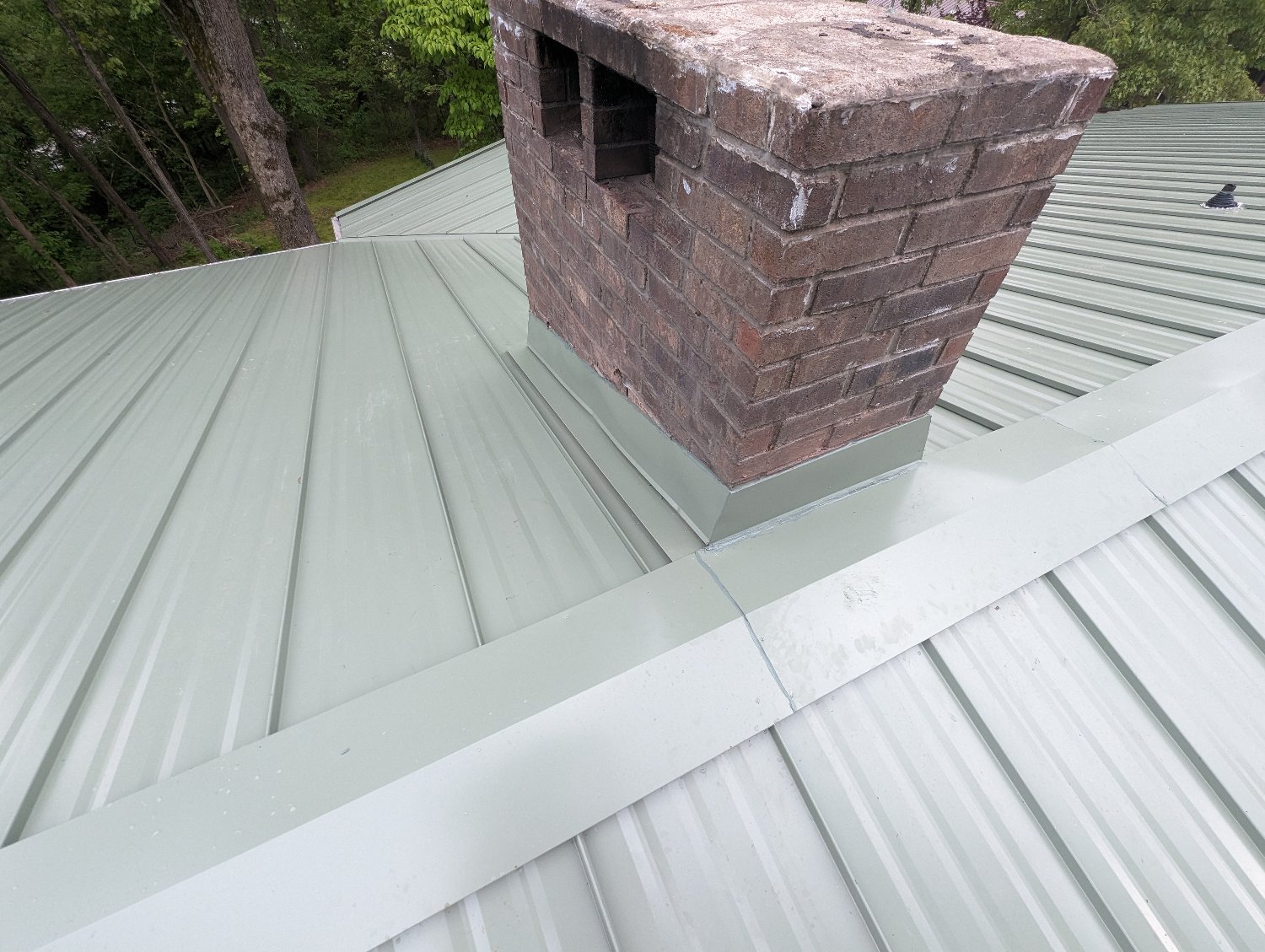Edit: Resolved. Decorative brick is actually a chase and doesn’t need to be completely filled in. Thanks to @[email protected] for advice on rebuilding the crown.
I have a double sided wood burning brick fireplace which is honestly just a big collection of code violations. It was converted to propane shortly after – I’m assuming – the people who built the house 50 years ago discovered that it smoked badly in the house. I fixed all the major issues with the firebox and smoke chamber and converted it back to wood burning this past winter.
I had a new steel cap fabricated to replace the old brick and concrete cap, which I removed. During this process, I discovered that the brick is basically just a facade. There are huge gaps on either side of the flues which are encased in 4" cinder blocks. My understanding of fire code (at least in the US) for masonry fireplaces is that the material surrounding the flue is not permitted to have any gaps in it. NFPA says all gaps in the brick should be filled with mortar. However, I’m not sure what to do with a gap this large. I’m not sure if filling it with mortar or concrete is an option. I’ve considered installing a steel flue liner but those are expensive and there are two flues. I’m also concerned about steel liners changing the draft characteristics since the chimney is on the short side.
If money were no object, I would tear this thing out and put a more efficient steel insert in but that is cost prohibitive.
Anyone have any experience fixing something like this?
I think you’re okay here – the code requirement about solid or fully-grouted blocks applies to the masonry supporting the flue liner. What you’re looking at in the photo is a decorative brick wrap around the structural portion of the chimney. My main concern would be to ensure that this area is properly capped and sealed so that critters and rainwater can’t get into the cavity and find their way further into your home.
I hadn’t thought of it that way. I suppose the decorative brick could be just considered a chase. I haven’t been able to find any similar examples so I wasn’t quite sure what I was looking at.
The left side flue was appropriate when it was built with a closed chase supporting the flue tiles. The right side has no flue tiles and would only be acceptable like a 100 years ago.
Sorry, I suppose I should have clarified that. The right side is the “gap”. Both flues are lined with clay tiles. The left flue is not visible in the picture.
Does the wall dividing the gap and the flue tiles visible from the top go all the way down or does it stop after a few bricks and then just has the flue stack naked in the chase?
From what I can tell it goes all the way down.
So it is basically a closed chase with brick surrounding the flue. That isn’t how it would be built today, but very common on most older homes. What you really don’t want is naked flue tiles in an open chase with no brick supporting them because they will be prone to serious failures like the tile stack collapsing.
You don’t really need to worry about that cavity. They want the brick cores filled and adequate mortar joints in the brick, not dry set(no mortar).
Construct a new crown to seal off the chase and extend the flue tiles by about 6" off the top of the new crown. There is a chance of a cross breeze pulling smoke down the adjacent flue, but there are a few factors that can cause that and I would need a few photos of the whole picture to have a decent idea if that could be an issue.
That makes me feel better. There was no crown initially. The flue tiles terminated flush with the brick inside the chimney cap. The old cap made cleaning and inspecting the flues difficult. It also had a fair bit of water damage.

What would I use as a base for the new crown?
Yeah, those suck. Good call on ripping it off.
I would use a grinder to put rebar down over the gap, set into the bricks, put cement board on top of that which has a 1/2" overhang onto the brick. I am extra and would do a rebar every brick across the short side. From there you can built a mold to pour a rebar and concrete slab with a 2" overhang, or no overhang if your rain cap can accommodate the tile extensions. The overhang will help to protect the mortar joints of the brick, so if your cap has less drip edge, I would just pour with the overhang. You do want to make sure the concrete is shaped to allow for water runoff, water sitting on the crown will fuck shit up faster if it sits. Use some foam seal around the tiles to give some relief for expansion and contraction. Seal over the foam with an exterior polyurethane sealant so water will have a harder time acting on the joint between the tile and the concrete.
If you elect to have the tiles with their own individual rain caps, I would suggest adding a sand cap over the concrete to act as a sacrificial wash. You’ll want to slip a tuck pointing trowel up against the tile to give some expansion room. Seal that wash to the tile with polyurethane as well. You don’t need more than an inch thickness, tapering to 1/2" at the edge. You will have to replace/patch that sand cap every so often, so make sure to check on it. Most of the time you just need to patch it with the leftover sand cap thinned out and applied with a brush, but you can use mortar as well.
That’s true if the right side is a flue, but with neither fire brick nor flue liner in evidence, I suspect it’s purely decorative – I’m interpreting OP’s text description to mean that we’re looking at one of two lined flues, and one of two unexpected void spaces he found when removing the cap. I don’t think the void is actually connected to anything, and instead is just decorative, but if I’m wrong and you’re correct, then yeah – there are more serious issues to deal with here
I’m certain neither flue would meet modern safety standards, and that is just from what I can see in that picture with very little information. There are some grandfathering of some issues.
Both flue almost certainly has deteriorated mortar joints or damaged tiles. You would need to have the flue camera inspected(level 2 inspection).
The right flue is fully fucked and should not be used. The tiles are gone and there is masonry that has fallen and is obstructing the flue.Edit: Not a flue, is open chase cavity.To determine if the flue will be able to have a stainless liner, you need the measurements of the firebox width, depth, and rear wall width. You then can put those measurements into an online calculator to determine liner size. The next problem is how much space you have in the chase(chimney structure surrounding the liner). If your chase has an opening of 10"x10" and you need an 11" liner, that is a problem.
The flue may be able to be coated with a masonry product like Fireguard or Fluesaver. That would depend on the condition of the flue tiles and the exact system used to reline.
The top of the chimney should not be closed off with a cap like you have there. It should have the tiles or a liner extending past the crown(top) of the chimney, the crown would close off the chase and keep water, debris, animals, etc. from being able to enter the chase. Water and products of combustion acting on the mortar joints of tiles and brick will destroy the structure. Just putting that cap on there is better than nothing, but it is more of a way to buy time so you can actually fix it properly. The crown used to be covered and sealed properly, but has deteriorated to the state it is in now.
Get a certified chimney sweep out there for a level 2 inspection of both flue and they will be able to give you a better understanding of what all needs to be done and you can go from there. Use a company that does the inspections and the work. If they don’t do the work, then you will have to deal with inaccurate quotes and a bigger headache. Just do an inspection on the right one, no sweep. They should be swept with the inspection to get a good idea of the tile and mortar joint condition.
Edit: fixed some stuff based on further explanation of the situation.
Not the answer you’re looking for but we just put a cap over our double chimney. Our area has terrible pollution problems and, although we liked having fires, we’re happier not contributing to the area’s bad air.
I pulled out some of my chimney from 1929. In the center it was the rounded rectangular clay pipe, stacked up. Surrounded by bricks which supported the clay pipe and had air gaps on both sides like you are showing. This was an old chimney that used to go to the boiler in the basement - not a fireplace.


